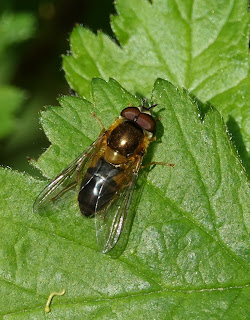Bombylius major (c) John Showers
Two other species may yet occur in Northants. The spotted bee-fly Bombylius discolor is expanding its range northwards. It has a dotted pattern on the wings rather than the intense dark front edge of B. major. The anthracite bee-fly Anthrax anthrax was found for the first time in Britain in Cambridgeshire last year. This latter species has been expanding its range in Europe and regularly visits bee hotels where it parasitizes the guests!
Although it is still rather cold, the dry and often sunny conditions at present create microclimates in sheltered areas and these are good places to find hoverflies, especially if there are nectar sources present. A walk round West Lodge Farm near Desborough on 19th April revealed 9 species of hoverfly. I managed to photograph a few and have attached the photos below together with the species distribution map up to the end of 2015 for Vice-county 32 - Northamptonshire and the Soke of Peterborough (historical Northants). The maps were supplied by Stuart Ball who jointly runs the UK Hoverfly Recording Scheme with Roger Morris. My thanks go to them for supply the maps and encouraging the study of hoverflies.
Rhingia campestris the Heineken Hoverfly on red campion (c) John Showers
(c) Stuart Ball
Cheilosia illustrata, a bumblebee mimic (c) John Showers
(c) Stuart Ball
Epistrophe eligans, a typical Spring species of woodland edges (c) John Showers
(c) Stuart Ball
Eristalis pertinax, a common species whose rat-tailed larvae live in wet conditions (c) John Showers
(c) Stuart Ball
As you can see from the maps, these are widespread species. The gaps probably reflect lack of recording effort rather than real gaps in the distributions.
In addition to hoverflies I did find a number of other interesting flies:
The parasitic fly (Family - Tachinidae) Gymnochaeta viridis. A Spring species whose larvae parasitise grass stem-boring Noctuid moth caterpillars. (c) John Showers
The long-palped cranefly (Family - Tipulidae) Tipula varipennis. A common Spring species.
(c) John Showers










